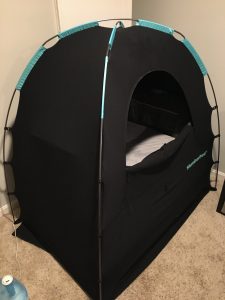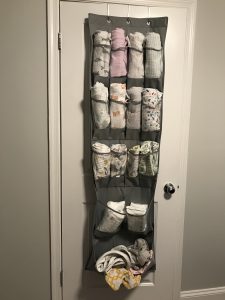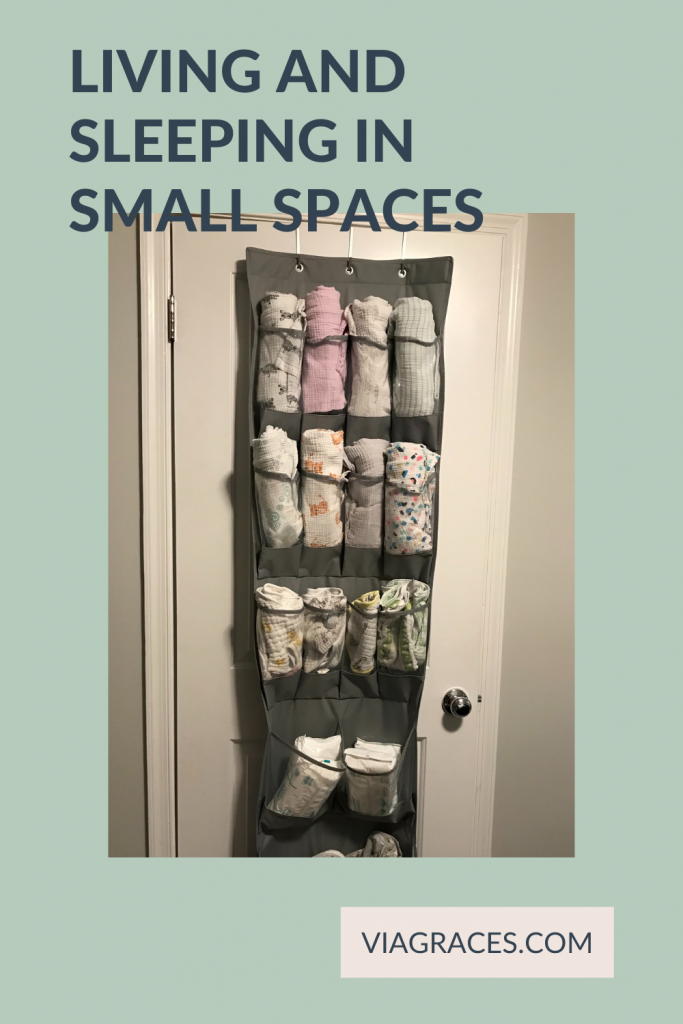Since getting married, Jason and I have always lived in small spaces. When we got pregnant with Olivia, we were in a one bedroom apartment, and I wasn’t quite sure how we’d make our space work since it was already tight.
And I had my melt downs about not having space for an actual crib and not getting to decorate a cute nursery for her. But we made it work until she was two, and it was great!
We then survived the nomad life for seven months as we lived with various friends, either in one or two of their bedrooms, and it was during this time that we became a family of four.
Now we’re finally in our own space, living in a two bedroom basement apartment, figuring out how we actually operate as a family of four! Olivia currently has her own room and Avery is rooming with us, and in a few months we will transition to having the girls share.
Living in small spaces can be tricky, especially when you add kiddos to the mix, but it’s absolutely possible and we’ve learned a few tricks along the way!
Less is More
There are SO MANY baby products out there that you just don’t need. When making a baby registry, don’t worry about toys. People will inevitably give you some and you don’t need any extras.
When deciding on the items you do want, think about what you (or your baby) will be able to use for a long time. If there’s something you really want but would only be necessary for a few weeks or months, see if you can borrow it from a friend!
Or if there’s something you’ll want for a while but can borrow it from a friend that whole time, even better!
Oppositely, when it comes to cost, sometimes more is actually better. There are some products out there, such as this bouncer (I swear by it!) and this jumperoo, that may cost more than other similar products, however the fact that they can fold up is key for small spaces and storage!
A Barrier
Many parents choose to room share with their infant and then move their baby to his or her own space when they’re ready (they, meaning either the parents or the baby!), but we didn’t have that option.
Olivia slept next to our bed when she was a newborn, but around four months we wanted some sort of separation, both for our sake and for hers, so we moved her into our closet. That’s right, our closet!
We had a walk in closet that a pack ‘n play fit perfectly in; so “nursery” on one side, closet/storage on the other. We kept the door cracked open (actually, it couldn’t shut with our hanging shoe rack), but it provided a barrier between us and Olivia, which was key to sleep training (as well as an easy solution to a perfectly dark room).
When you’re ready for some sort of separation from your child, but either don’t have another room or aren’t yet comfortable being in separate rooms, my favorite barrier is the SlumberPod.

It’s an amazing invention that we are currently using with our second babe and will forever travel with.
When zipped up, your baby/toddler’s sleeping environment is totally dark, and it feels as though they have their “own room.”
With our current set up, you have to walk through our bedroom to get to Olivia’s, so there are several times we walk right through our room while Avery is sleeping. But because she’s in the Slumberpod, the hallway light and people walking by doesn’t make any difference!
(Bonus: use the code “VIAGRACESPOD” for a discount on your very own!)
You can also use a tension rod with a shower curtain to make a barrier, or use command hooks, twine, clothes pins, and a sheet to make a barrier; anything that helps the space feel more “separate.” This will help with everyone’s sleep!
Many people think it’s impossible to sleep train when room-sharing, and I’m here to tell you it’s absolutely possible! Harder, probably, but very worth it. The keys are darkness (so baby can’t see you during night wakings), a plan (when and how will the parent respond), and consistency.
Use Vertical Space
Small spaces generally don’t come with very much storage, so you have to get creative. My favorite “hack” has been this hanging shoe rack.
In each space we’ve lived since having kids, this trusty door hanger has come with us and kept us organized without stealing closet or dresser space! You can also find diaper caddies that hang right on the wall, floating shelves to display pictures or keepsakes, and behind-the-door hooks for extra bags or jackets.

My biggest frustration with small space living with children is that nothing ever seems to get done when you want it to. We can wash and fold the laundry, but we can’t put it away because the clothes go in the bedroom where the kiddo is sleeping.
Our room is a mess, but we can’t clean it with the toddler awake because she makes a mess as I clean, and I can’t clean it while she’s asleep because, well, she’s asleep in the messy room. When we do have the chance to clean and organize, we can only get so tidy because the reality is, there just isn’t a “home” for everything, so we’re in a constant state of clutter.
But there are also major pros! I am a natural pitcher and purger, and living in small spaces really keeps me on my toes thinking through what’s really necessary to keep.
I also think our girls are deeper sleepers because of it. We can run the laundry on the other side of the wall from Olivia’s closet/room, have company over while the girls sleep rather than tiptoeing around or whispering, and us coming in and out of the room at night doesn’t stir them.
And let’s be real…my past melt downs about Olivia not having an actual crib and cute nursery are now panics about how in the world to decorate a whole room for her! Finally, if we’ve learned anything over the last few years of living in small spaces and sharing spaces with people, it’s not the size that determines if it’s “home,” it’s the people.
With Grace,
Lauren
